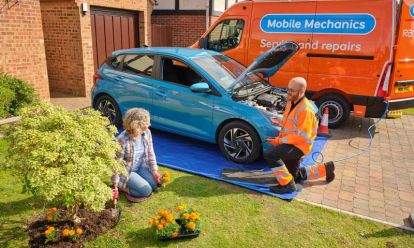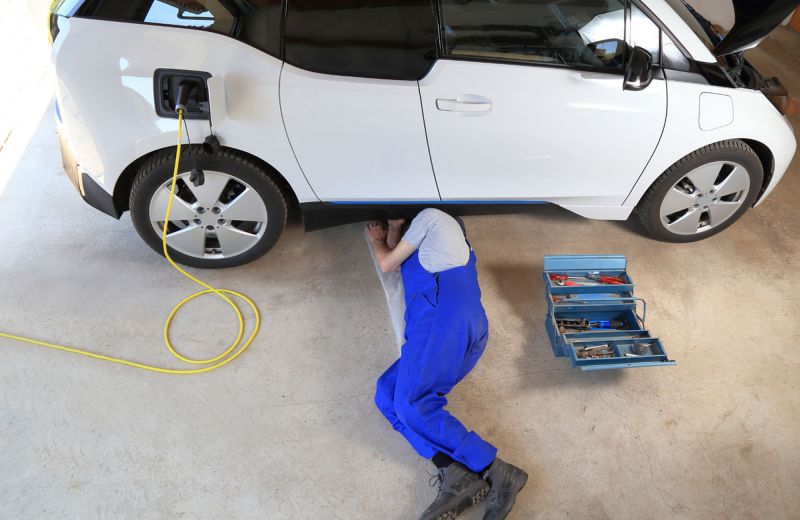The reason is simple. The electric motor, batteries and EV transmission have fewer moving parts than the engine and gearbox of an internal combustion car. This means there is less to go wrong. However, as this guide will explain, an EV still needs regular servicing.
- RAC Car Care – everything you need to look after your car
- Types of electric vehicles – EVs explained
- 2035 ban – is it worth buying an electric car now?
What needs servicing on an electric car?
Electric motor(s) and batteries
These need very little maintenance. All you should need to do is to follow the car manufacturer’s recommended service schedule.
Oil and coolant
Oil is used in the transmission of an EV and coolant chills the batteries. Both of these require topping up or changing far less frequently than in a combustion-engined car.
Brakes
As EVs use regenerative braking, wear to brake pads and discs is dramatically reduced. However, they will still need replacing periodically.
Tyres
Due to the weight of the batteries, electric cars are often heavier than combustion-engined vehicles. Their instant accelerative torque can also increase tyre wear.
The minimum legal limit for tyre tread depth in the UK is 1.6 millimetres, measured across the central three quarters of the tread around the tyre’s complete circumference. It’s sensible to replace tyres when the tread depth reaches 3.0 millimetres. Below this depth, stopping distances can increase dramatically.
Suspension
As with tyres, the increased weight of electric cars can wear out springs and dampers. But don’t worry, these will be checked as part of any major service.
Other consumable items such as air conditioning pumps, cabin filters and wiper blades will need replacing over the car’s lifecycle.
- Buying a used electric car
- Electric car insurance – is it cheaper?
- The road to electric - in charts and data

RAC sale – up to 33% off*
• Roadside cover from £5.49 a month*
• We get to most breakdowns in 60 mins or less
• Our patrols fix 4/5 breakdowns on the spot

How often do electric cars need servicing?
Most electric vehicles need servicing much less frequently than either petrol or diesel cars. For example, Renault recommends intervals of 18,000 miles for the Zoe2, compared to 9,000 miles for its petrol cars.
Volkswagen electric cars – such as the ID.3 and ID.4 – have a fixed service schedule like combustion-engined vehicles, with the first inspection due after two years. Following that, it is recommended that a service is carried out annually or every 18,000 miles, whichever comes up first.
Hyundai has similar electric vehicle service plan intervals for its petrol and hybrid cars, at 10,000-mile intervals in the first year, 20,000 miles in the second year and so on, whichever milestone is reached sooner.
- Contact your local mobile mechanic in your area if you struggle with EV service or repairs
- Types of electric vehicles – EVs explained
- How long do electric car batteries last? EV battery recycling
Servicing an electric car is made simpler by the fact that almost all car manufacturers offer a service plan for electric vehicles. Like a mobile phone contract, these can be paid monthly or with an upfront cost, and entitle you to a fixed range of benefits.
Renault’s Zoe electric car service plan costs £299 for three years and 30,000 miles, compared to £499 for a petrol or diesel car over the same period.
For Audi’s range of E-tron models, service plans start with an upfront cost of £299.25. This includes one service, one brake fluid change and one pollen filter change. A service plan for a 2.0-litre combustion model starts at £449.25.
For the first year of ownership, Vauxhall offers a core electric car service priced from £90, rising to £239 with the addition of a cabin filter check. However, you shouldn’t need to pay anything if you buy a brand-new Vauxhall EV, as they currently come with three years of free servicing.
A brand-new combustion Vauxhall service plan costs from £19 per month for a three-year period, and covers the first, second and third annual services, two years Vauxhall Roadside Assistance and the first MOT.
As a general rule, service plans do not cover ‘wear and tear’ items such as brake components, tyres, or windscreen wiper blades.
- Electric vehicle range – how far can I drive in an EV?
- Electric car charging – how it works and how much it costs
- Best SUV Hybrids of 2022
You may also be able to reduce your EV’s maintenance costs. For example, battery life can be extended by not driving with a charge of less than 20 percent for extended periods of time.
Typically, an EV battery is guaranteed for eight years. Reassuringly, this is much longer than the mechanical warranty for the car itself, which is commonly three, five or seven years.
An electric vehicle can be serviced by either a manufacturer-approved dealership or an independent garage while within its warranty period. However, if you lease an electric car, you may find you are contractually required to have it serviced within the franchised dealer network (check the financial agreement to confirm this).
If you do decide to maintain the vehicle outside of the franchised dealer network, you must ensure the car is serviced within accordance of the manufacturer's service schedule and instructions. For example, the garage must use approved parts and fluids (which must be documented on an itemised invoice). If the independent garage fails to do this, you may find you’ve unwittingly invalidated the car’s warranty.
That said, you may find it cheaper to take it to an independent garage for maintenance; however, as EV technology is still quite new, it can be more of a challenge to find a specialist capable of carrying out maintenance, but the good news is that it’s far from impossible.
What happens if an electric car breaks down?
Overall, with the benefit of fewer moving parts, electric cars are mostly very reliable. However, if they do break down, they can’t be towed, because of how the electric motors are connected to the wheels, the absence of a neutral gear, and because the batteries don't generally like being positioned at an angle or exposed to strange forces.
However, don’t worry if your EV should break down. The RAC is leading the way when it comes to supporting drivers in the switch to electric vehicles.
Our All Wheels Up recovery service can help stranded EVs, as our patrol vans have a fold-out trailer which can lift all four wheels of a broken-down EV.
This saves drivers from needing to call out an additional recovery vehicle, and can even be carried out with one of our Heavy Duty 4x4 patrol vans.
If your breakdown is caused by a flat battery, the RAC’s EV Boost service can help. Pioneered in 2019 to help stricken electric cars, a lightweight and portable EV charger powered by the patrol van’s engine can provide enough power to get to a nearby charge point.
Overall, servicing and maintaining an EV isn’t a daunting prospect. In fact, it should be easier than running an internal combustion-engined vehicle. And, even if the worst happens and you break down in your electric car, the RAC has you covered.
1 https://www.goultralow.com/wp-content/uploads/2016/05/go-ultra-low_2016_aw_web.pdf
2 https://www.renaultgroup.com/en/news-on-air/news/all-there-is-to-know-about-electric-car-maintenance/
Get a car service at home
RAC Mobile Mechanics can come to you, saving you the hassle of going to a garage.












